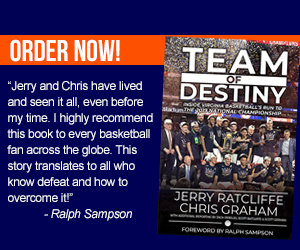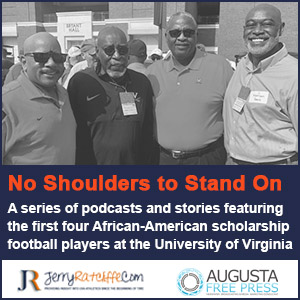Elliott: Running game is critical to our success
By Jerry Ratcliffe

Mike Hollins leaps into a gap in the Liberty defensive line on a first-down run in 2019. (Photo: John Markon)
For years, Virginia football fans have been promised a running game they could rely on. Never happened, unless one considers the quarterback as the primary ball carrier.
Bronco Mendenhall, at least for the past couple of seasons, said the running game should be the best it had been during his time here. It wasn’t. Instead, he turned over the reins to pass-happy offensive coordinator Robert Anae and we all saw what resulted, .500 football.
Don’t get me wrong. Watching Brennan Armstrong put up huge passing yardage was thrilling.
The old coaches will tell you that largely passing numbers are losing numbers.
Effective passing games are enhanced by supportive running attacks, and that’s what has been missing at UVA for a very long time.
Tony Elliott aims to end that notion. Certainly he will take advantage of Armstrong’s strong arm and his ability to run as a dual-threat QB. There has to be more. There has to be an effective running game.
Elliott is trying to build a base for that in the limited 15 spring practices, and it isn’t easy when half your linemen are either on the mend from offseason surgery or haven’t arrived through the transfer portal.
Would have been much easier if the entire starting offensive line had stayed put and not entered the portal themselves. Woulda, shoulda, coulda.
I asked Virginia’s new head coach recently to share his philosophy on the run game in the big picture and he gladly obliged.
“It’s critical,” Elliott said. “We want to be balanced, and sometimes that gets misinterpreted. Some people think, ‘Well, you’ve gotta be 50-50 run-to-pass.’ No, that’s not what we’re saying.
“When we say balance, we’re effective running the ball and sometimes that means three yards is an effective run. If you can stay ahead of the chains or you can convert a short-yardage running play, that’s what we’re trying to establish.”
How many times have we watched Virginia fail to rush for one or two yards at critical juncture, including last season’s late-game debacle against Virginia Tech that led to the nonsensical tackle-eligible pass behind the line of scrimmage to lumbering tackle Bobby Haskins, who was buried along with Virginia’s hopes of winning the Coastal Division? Yes, another Anae stroke of brilliance.
Elliott had more thoughts on what a running game means to his offense, particularly after being part of Clemson’s machine the past dozen years.
“And then, just for us offensively, and from a team standpoint, being able to run the football sets the tempo for the team,” the coach explained. “It forces the defense to practice against the run and now they’re developing that physical mindset.
“You have a physical mindset up front, and then you have confidence that when it’s time for when the game is on the line and it’s time to go run the football, that you can go convert whatever you need to convert running the football. So [the running game] is critical to our success.”
It has been more than a decade since Virginia’s running game finished in the ACC’s top five. Not since 2011 — Mike London’s best season at 8-5 — has UVA enjoyed a powerhouse running game. The Cavaliers, on the strength of Perry Jones’ powerful legs, finished fourth in the league that season in rushing.
Three times (2016, 2017 and last season), UVA was dead-last in the league in rushing (only 121.8 yards per game in 2021.
After Saturday’s sixth practice, Elliott was admittedly hoping his offense would be further along, but he understood why.
“We’ve got 10 linemen and there’s been days when we’ve had eight linemen, and so if you’re running two groups, you need at least 10 linemen, meaning guys are doing double duty,” Elliott said.
That has meant Jonathan Leech has been going from right tackle to left tackle, to left guard to right guard. Ty Furnish is playing center and guard. Derek Devine is playing guard and tackle. Who’s on first and What’s on second?
“When you’re installing a new offense, new schemes, different calls, different verbiage, that’s tough for those guys,” Elliott said.
If that wasn’t enough to complicate the matter, then the spring’s best performer at running back, Ronnie Walker Jr., a fifth-year from Hopewell via the transfer portal last season from Indiana, was injured in live action and his spring is over.
“Ronnie was having the best [spring] up until he got hurt the other day in practice,” Elliott revealed. “He took a shot on his leg and he will be out for a little while. He was having a really, really good start to spring, just very consistent, workman-like, was gonna do what you asked him to do.”
Amaad Foston, a 6-foot, 210-pound redshirt freshman running back from Milledgeville, Ga., is trying to “feel the offense,” in Elliott’s words.
Elliott’s offense, led by OC Des Kitchings and running backs coach Keith Gaither, is different than last year’s under Mendenhall.
“It’s a little bit different,” Elliott said. “Outside zone, inside zone, from three different alignments, that’s tough on a back.”
Mike Hollins, a 5-9, 210 running back from Baton Rouge, La., hasn’t really touched the ball much during his two previous seasons at Virginia. Armstrong and Bryce Perkins, running quarterbacks that have led the team in rushing the past few seasons, have many more touches than Hollins, who has potential.
“Mike, I believe, is the most talented of the [running backs] group,” Elliott said. “The first couple of days, we were on him pretty hard. It was just practice habits, the little things, just trying to go above and beyond. That’s what I’m trying to get established with everybody, that whatever somebody else suggests, that it’s just a suggestion. Like, that’s not our standard.
“Our standard is set above what anybody else expects of us, so he’s one guy that I’m just trying to pull through the knothole. He wants to, but he’s got to be consistent.”








